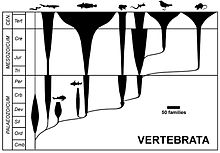Alfred Romer
Alfred Romer | |
|---|---|
| Scientific career | |
| Fields | Paleontology |
| Institutions | Museum of Comparative Zoology |
| Thesis | The Locomotor Apparatus of Certain Primitive and Mammal-like Reptiles (1922) |
| Doctoral advisor | William King Gregory |
Alfred Sherwood Romer (December 28, 1894 – November 5, 1973) was an American
.Biography
Alfred Romer was born in White Plains, New York, the son of Harry Houston Romer and his wife, Evalyn Sherwood. He was educated at White Plains High School.[2]
He studied at
Evolutionary research
Romer was a keen practical student of vertebrate evolution. Comparing facts from paleontology, comparative anatomy, and embryology, he taught the basic structural and functional changes that happened during the evolution of fishes to ancestral terrestrial vertebrates and from these to all other tetrapods. He always emphasized the evolutionary significance of the relationship between form and function of animals and their environment.
Through his textbook
Namesakes
Taxonomic patronyms
In honor of Alfred Romer, several
- and their closest relatives.
- Romeria is a genus of early captorhinids.
- Tetrapoda.[10]
- Dromomeron romeri is a species of non-dinosaurian dinosauromorph named in July 2007. The genus name means 'running femur,' and the species name honors the paleontologist, a key figure in evolution research. The finding of these fossils was hailed as a breakthrough proving dinosaurs and other dinosauromorphs "lived together for as long as 15 to 20 million years."[11][12]
Romer's gap
Romer was the first to recognise the gap in the fossil record between the
Romerogram

A romerogram, also called spindle diagram, or bubble diagram, is a diagram popularised by Alfred Romer.[14] It represents taxonomic diversity (horizontal width) against geological time (vertical axis) in order to reflect the variation of abundance of various taxa through time.[15]
Books
- Romer, A.S. 1933. Vertebrate Paleontology. University of Chicago Press, Chicago. (2nd ed. 1945; 3rd ed. 1966)
- Romer, A.S. 1933. Man and the Vertebrates. University of Chicago Press, Chicago. (2nd ed. 1937; 3rd ed. 1941; 4th ed., retitled The Vertebrate Story, 1949)
- Romer, A.S. 1949. The Vertebrate Body. W.B. Saunders, Philadelphia. (2nd ed. 1955; 3rd ed. 1962; 4th ed. 1970)
- Romer, A.S. 1949. The Vertebrate Story. University of Chicago Press, Chicago. (4th ed. of Man and the Vertebrates)
- Romer, A.S. 1956. Osteology of the Reptiles. University of Chicago Press, Chicago.
- Romer, A.S. 1968. Notes and Comments on Vertebrate Paleontology. University of Chicago Press, Chicago.
- Romer, A.S. & T.S. Parsons. 1977. The Vertebrate Body. 5th ed. Saunders, Philadelphia. (6th ed. 1985)
Sources
- S2CID 73207256.
- ISBN 0-902-198-84-X. Archived from the original(PDF) on 2016-03-04. Retrieved 2018-04-10.
- ^ a b "Alfred Sherwood Romer". American Academy of Arts & Sciences. 9 February 2023. Retrieved 2023-02-16.
- ^ "APS Member History". search.amphilsoc.org. Retrieved 2023-02-16.
- ^ "Mary Clark Thompson Medal". National Academy of Sciences. Archived from the original on December 29, 2010. Retrieved 15 February 2011.
- ^ "Daniel Giraud Elliot Medal". National Academy of Sciences. Archived from the original on August 1, 2012. Retrieved 15 February 2011.
- American Academy of Achievement.
- ^ "Romer, Alfred Sherwood." Complete Dictionary of Scientific Biography. 2008. Retrieved May 25, 2011 from Encyclopedia.com: http://www.encyclopedia.com/doc/1G2-2830905302.html
- S2CID 10481925.
- .
- ^ Andrew Herrmann (2007-07-20). "Grad student finds 'pre-dinosaur'". Chicago Sun-Times. Archived from the original on 2008-10-13.
- S2CID 6050601.
- PMID 17065318.
- ^ "Evolutionary systematics: Spindle Diagrams". Palaeos.com. 2014-11-10. Retrieved 2019-11-13.
- ^ "Trees, Bubbles, and Hooves". A Three-Pound Monkey Brain — Biology, programming, linguistics, phylogeny, systematics …. 2007-11-21. Retrieved 2019-11-13.
External links
- Chrono-Biographical Sketch: Alfred S. Romer
- NAS Biography of Alfred Romer
- Alfred Sherwood Romer (AC 1917) Papers at the Amherst College Archives & Special Collections
